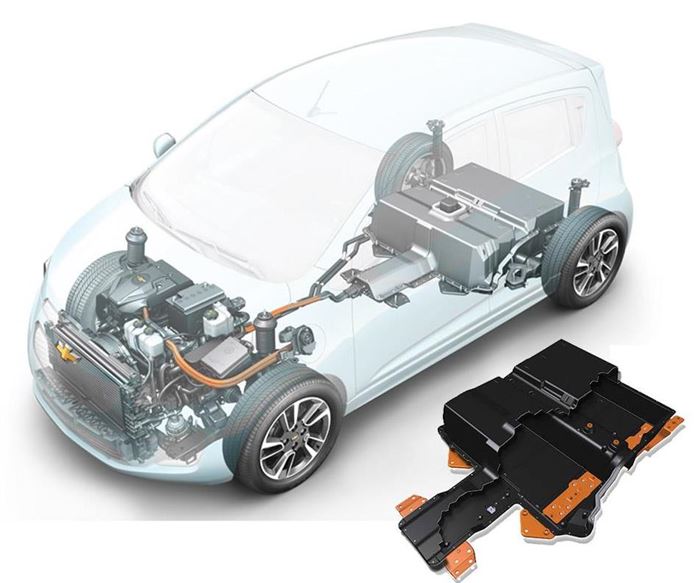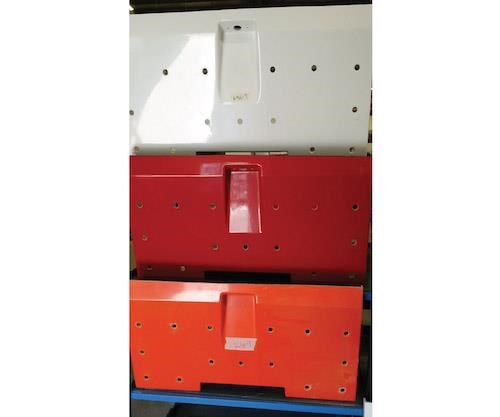Styrene-free resins: More than emissions reduction
Since the first introductions of low- and no-styrene resins, the emphasis has shifted from mere compliance to comparable — or better — performance.
Long favored for their processing characteristics, mechanical properties and relatively low cost, styrene-based resins, such as unsaturated polyesters, have been the go-to, workhorse polymers for composites fabricators who make products for the marine, spa, sports board and a host of other industries. In anticipation of increasingly more stringent regulations, however (see “Styrene regulatory update,” p. 43), resin formulators have developed fully commercial lines of styrene-free resins. These products are designed, as much as is feasible, to be “drop-in” alternatives to currently sold styrenated products should regulations at some point mandate replacements. At present, however, they serve a variety of practical needs, from helping to meet emissions requirements to improving worker comfort and safety, within the composites industry.
Offerings options to open molders
Targeted primarily toward the marine and bathroom/spa market, styrene-free H164 polyester resin from AOC LLC (Collierville, TN, US) is a medium-reactive, thixotropic resin designed for the appli- cations most vulnerable in the current regulatory climate: hand lay-up or spray-up laminating processes. AOC’s R&D director John McAlvin says that, from a performance standpoint, H164 compares favorably with unsaturated polyester resins that contain dicyclopentadiene (DCDP), a standby compound used in resins favored by the boat and tub-and-shower industry.
“The resin has comparable strength and modulus and better elongation than DCDP[-based] resins, and comparable heat- distortion temperature,” McAlvin reports, noting these particular properties are important to fabricators in the spa and boat markets to which the resin is targeted.
Luck does not play a role in achieving such improvements in properties. Taking a standard, off-the-shelf, unsaturated poly- ester and dissolving it in non-styrenic monomers — for example, acrylates — will most likely yield a resin with poor mechanical properties, McAlvin notes, because the functionalities of the two components are incompatible. The key is proper engineering of the polyester resin. In the case of H164, the polyester’s polymer backbone has been redesigned with chemical functionalities that are compatible with those of the monomers — a propri- etary mixture of alternate molecules — which, in turn, promotes copolymerization.
H164 can be used with all types of open-molding equipment and, as such, can be considered a drop-in replacement for styrene- based resins, with one caveat: Like other styrene-free products, H164 can remain tackier longer and require more time to fully cure, a process carried out at room temperature. Within its limits, however, the resin can be tailored to specific gel and cure times as necessary to meet the requirements of the application.
AOC also manufactures several grades of styrene-free resins for composite cured-in-place pipe (CIPP) applications, including an isophthalic grade, EcoTek L704-FAHG-VT. The high-molec- ular-weight resin is thinned with vinyl toluene. It contains no hazardous air pollutants and its combined renewable bio-derived content and/or recycled content is 16%, yet it provides the corrosion resistance, durability and toughness that is required for cured-in-place sewer-pipe applications
“Our objective is not to replace styrene-based products, but to give fabricators options,” McAlvin says. In addition to being regulated under the Federal Clean Air Act as both a hazardous air pollutant (HAP) and a VOC, styrene emissions also might need to meet guidelines set by state and local laws, which in some cases can be more stringent than federal. Under the various permitting requirements, a fabricator might need to switch to a styrene-free product at a certain time of the year in order to remain in compliance, says Frank Sizemore, director of regulatory affairs at AOC, noting specifically that in reference to styrene, the US state of California’s stringent local permitting requirements actually exceed the federal limits. Late in the year, therefore, when the molder nears its local emissions limit, it switches to the styrene-free resin. It’s a more cost-effective strategy than running the styrene-free resin exclusively because there is a price premium for the styrene- free product.
Striking a balance between styrene-based and styrene-free resins, Ashland Performance Materials’ (Dublin, OH) Aropol L 67214 is a reduced-styrene resin. Introduced to market in 2015, the resin is intended as a complement to the company’s line of general marine laminating resins. Aropol L 67214 meets the desired appearance and processing times of standard styrenated resins, yet reduces styrene emissions by 30%, according to Charlie Fisher, North American marine industry manager. Additionally, the resin is more cost-competitive than the styrene-free systems, has faster barcol and reduced shrinkage.
“There is a noticeable reduction in styrene odor during spray and rollout, which leads to a healthier and happier workforce,” Fisher reports.
CF prepreg for volume applications
On the market for about three years, Reichhold’s (Durham, NC, US) trademarked Advalite resins comprise two product groupings: a liquid vinyl ester hybrid resin and a monomer-free vinyl ester hybrid hot-melt grade. The liquid vinyl ester hybrid version, which does not contain reactive diluents, is targeted mainly toward pultrusion processes, but also can be used in filament winding, RTM and other closed molding process. The Advalite hot-melt grade is used in the manufacture of prepregs and was initially developed for applications that require low residual styrene.
In the first such applications for the Advalite hot-melt, Reich- hold partnered with then Cytec Industries (Woodland Park, NJ, US), now Solvay (Brussels, Belgium), in the development of the composites industry’s first fully commercial, VOC-free thermoset, vinyl ester hybrid resin woven-glass reinforced prepreg, which is currently used to manufacture the Chevrolet Spark EV batter enclosure (see Learn More). The enclosure, manufactured from composites by Continental Struc- tural Plastics (Auburn Hills, MI, US), won a 2013 SPE Innovation Award in the Electrical Systems category.
Glade Gunther, Solvay North America’s auto- motive program manager, says the part was originally conceived as a metallic solution, including the possibility of a magnesium casting, but was changed when engineers realized the enclosure dimensions — a lower tray and mated cover about 150-cm long by 110-cm wide by 34.4-cm high — exceeded then current casting/tooling capability. As a result of their involvement in a concurrent project to develop composite materials for automotive under-body components, Solvay was aware of Reichhold’s styrene-free Advalite resin. Solvay subsequentl re-formulated its MTM23 resin using the Advalite resin. Additional materials testing and development work culminated in the successful production of a prepreg comprising its MTM23 hot-melt resin and 18-oz glass fabric, featuring fiber supplied by PPG Industries (Pittsburgh, PA, US) and woven by Chomarat (Anderson, SC, US). The finished, compression-molded tray and cover, together, have cut the enclosure weight, as originally conceived in metal, by more than 40%. Additionally, because the enclosure sits directly below the passenger compartment, required testing of the part for emissions of volatile compounds (part of the safety specifications regimen for head space) found no presence of either styrene or VOCs.
Solvay and Reichhold are attempting to capitalize on this and other benefits of the vinyl-hybrid resins — in particular, snap cures of 1-2 minutes and room-tempera- ture shelf life of up to a year.
Jim Bono, Reichhold’s senior technical manager, says the company worked in concert with a number of prepreg manufacturers and compounders to evaluate various grades of carbon fiber and types of sizing. Testing of samples prepared from filament wound Naval Ordnance Laboratory (NOL) rings, typically used in physical tests conducted to simulate burst pressures in pressures vessels, is used to determine which systems provide good interlaminar shear strength in an Advalite hot-melt matrix. “The prepreg systems we are designing ensure a snap-cure performance similar to SMC, and mechanical properties compare favorably to carbon/ epoxy systems,” Bono claims.
The company is currently working with partners to qualify the material for high-volume commercial automo- tive structures, such as battery trays and body pillars, as well as aerospace applications, where the dielectric properties of the carbon prepreg make it suitable for radome applications.
Fewer emissions, comparable performance
Although the regulatory climate, as it pertains to styrenated resins, is difficult to predict with certainty, the foregoing establishes that, today, styrene-free alternatives are not only possible, but commercial. But the future likely depends on the degree to which composites manufacturers are compelled to conform to tighter regula- tory strictures on the use of styrene or the sale of products that contain it and, ultimately, the timing of federal and regional decisionmaking, over which this industry has little control. What is certain is this: The already demonstrated will and skills of resin formulators will be key if suppliers are to field styrene-free resins that bring more to the table than fewer emissions, and go on to match or exceed the performance of the styrenated polymers they’re designed to replace.
Related Content
TU Munich develops cuboidal conformable tanks using carbon fiber composites for increased hydrogen storage
Flat tank enabling standard platform for BEV and FCEV uses thermoplastic and thermoset composites, overwrapped skeleton design in pursuit of 25% more H2 storage.
Read MoreInfinite Composites: Type V tanks for space, hydrogen, automotive and more
After a decade of proving its linerless, weight-saving composite tanks with NASA and more than 30 aerospace companies, this CryoSphere pioneer is scaling for growth in commercial space and sustainable transportation on Earth.
Read MorePlant tour: Joby Aviation, Marina, Calif., U.S.
As the advanced air mobility market begins to take shape, market leader Joby Aviation works to industrialize composites manufacturing for its first-generation, composites-intensive, all-electric air taxi.
Read MoreCryo-compressed hydrogen, the best solution for storage and refueling stations?
Cryomotive’s CRYOGAS solution claims the highest storage density, lowest refueling cost and widest operating range without H2 losses while using one-fifth the carbon fiber required in compressed gas tanks.
Read MoreRead Next
Developing bonded composite repair for ships, offshore units
Bureau Veritas and industry partners issue guidelines and pave the way for certification via StrengthBond Offshore project.
Read MoreVIDEO: High-volume processing for fiberglass components
Cannon Ergos, a company specializing in high-ton presses and equipment for composites fabrication and plastics processing, displayed automotive and industrial components at CAMX 2024.
Read More“Structured air” TPS safeguards composite structures
Powered by an 85% air/15% pure polyimide aerogel, Blueshift’s novel material system protects structures during transient thermal events from -200°C to beyond 2400°C for rockets, battery boxes and more.
Read More













.jpg;maxWidth=300;quality=90)














